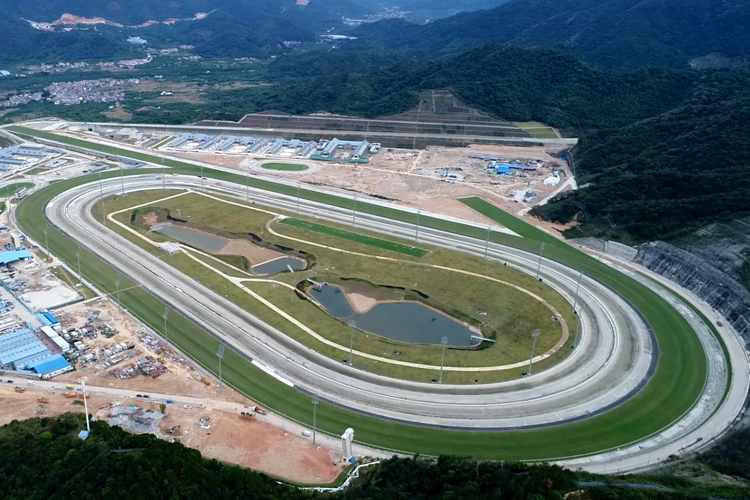3 minute read
It takes more than a moment to absorb the magnitude of the Hong Kong Jockey Club’s (HKJC) Conghua racecourse.

There are the precise numbers of cost and facilities, there is the size and what it must have taken to physically build the course on the green fields site in Guangdong Province 200 kilometres into the Chinese mainland, the massive management effort in liaising with multiple levels of government, the vision and what it means for the future of Hong Hong racing and Chinese equine development.
The numbers are almost the easiest aspect to consider; HK$3.7-billion construction cost, 150 hectares housing potentially 660 in-training horses at the current capacity; one 2000m turf track, two All-Weather tracks at 1780m and 1600m, an uphill gallop track of 1100m; an owners Lounge, trainers pavilion, broadcasting centre; nine stable blocks with eight single story and 68 stalls for two trainers and one double story with 120 stalls; equine swimming pool; 20 spelling paddocks; a world class, state of the art, veterinary hospital and farrier forge; on-site ICU medical facility for all staff; staff training facilities; customs port and building; staff living quarters; a fleet of specially designed cross-border horse float; the list is long and complete.
Finally the site operates with bio-security to the level of a quarantine station so that all horses have the same health status whether they are stabled and trained at either Sha Tin or Conghua.
The course was first designed and built as the equestrian venue for the Guangzhou 2018 Asian Games and now it is a massive, fully operational, training centre for Hong Kong racing that will become the bub of the equine industry for China.
The vision however starts back at Sha Tin. Built forty years ago Sha Tin was considered just as remarkable then as Conghua is now. Considered far out in the New Territories the concept of transporting horses into Happy Valley to race was new and in its own way ground breaking for the time.
Sha Tin now needs it own reconstruction and relief from the pressure of training on what are now older facilities at maximum capacity and the demand for more horse ownership from the HKJC membership.
“Sha Tin Racetrack is 40 years old and the infrastructure was built on reclaimed land with the stables built for horses, the quality of horses we had 40 years ago,” said Hong Kong Jockey Club Chief Executive Officer Winfried Engelbrecht-Bresges recently.
Modern feeding practices brings heavier horses to stables build on land sufficient to carry the weight of yesteryear runners.
“To further our racing we were keen to build new state of the art facilities. We have to invest approximately HK$150 million for the next phase to upgrade Sha Tin racetrack and in the intensive environment of Hong Kong we cannot just knock down stables,” said Engelbrecht-Bresges.
“Even if we rebuilt Sha Tin we will not be able to offer the facilities that we believe are necessary for the development of Hong Kong racing.”
This is the nub of the reason to expand with another racecourse, a fifty year vision including refurbishing Sha Tin, expanding training numbers with modern facilities and entering into a partnership with the neighbours in Southern China for a Greater Bay Area development of a centre of excellence for equine capabilities combined with tourism.
The vision is just as large as the physical presence of Conghua.
Working with the Guangdong Government, local officials in the Conghua area and the top level of government on Beijing the HKJC proposes an equine gateway for Mainland China through the Equine Disease Free Zone created for Conghua.
A new quarantine station is in the planning stage already for all horses entering China, racehorses, equestrian horses, breeding; the establishment of a China Vet School; Huangcun Equestrian Sports Training Centre; hosting global equine conferences; further develop equine training in China; the development of equine support industries such as feed and drugs; horse movement and equipment and ultimately a breeding industry with entry in and out of China through the quarantine centre.
“The HKJ has three racecourses, Conghua, Sha Tin and Happy Valley, as part of our assets with one of the best equine labs in the world. The Hong Kong government will design a specific government lab for everything that has to do with other equine diseases, so this would be a centre for China and this region for equine diseases,” said Engelbrecht-Bresges.
“We have funded the Hong Kong Vet School with the cooperation with multiple universities and we are looking at cooperation with the Agriculture University of Guangdong to build on this model and a Vet School for the development of the equine industry in China.
“Then we have training people for the development of an equestrian industry with farriers, grooms, all the people you need. All of this we can practically do in this Hub.
“What we want to do is to build an international quarantine station. One of the big issues for the Chinese and for us is if we think about a retirement farm in China we have missing a dedicated quarantine facility.
“But moreover we think for the long term development of an equestrian and thoroughbred industry in mainland China these horses need to acquire a health status that enables them to participate in competitions in either Conghua, Hong Kong or overseas. Alternatively we could have international competition where we have international horses competing in the disease free zone here,” he said.
As a parallel development path to this equine vision is building tourism around Conghua’s historic and famed hot springs attractions and national park status.
“What we want to do is to have some exhibition races at the Conghua Racecourse. This is not with gaming, but to showcase racing,” said Engelbrecht-Bresges.
“It will become a tourist attraction especially for Conghua, which is a really beautiful hot spring area and it will give us the opportunity to train people and staff.
“The first exhibition meeting will be on March 23rd, 2019, and this gives us a unique opportunity to showcase world class racing, world class jockeys and horses and it will create significant benefits for the local industry.
“They have marvellous facilities in Conghua and we want to leverage on this to jointly build tourism.
“This is the first step and this is the platform that we can build on. The feedback has been extremely good, especially here in Conghua as this is a brand opportunity which is unique which will give them global world-wide coverage,
“This will differentiate them from other tourist areas and that is why I think we will get extremely good support for all levels of government,” he said.
Conghua might have been a near ten year development including the Asian Games, but the 150 hectares of the site is one aspect of a large global picture with a vision that extends towards the horizon.








